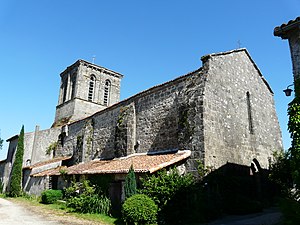La Peyratte
| La Peyratte | ||
|---|---|---|
|
|
||
| region | Nouvelle-Aquitaine | |
| Department | Deux-Sèvres | |
| Arrondissement | Parthenay | |
| Canton | La Gâtine | |
| Community association | Parthenay-Gâtine | |
| Coordinates | 46 ° 41 ′ N , 0 ° 9 ′ W | |
| height | 102-192 m | |
| surface | 46.86 km 2 | |
| Residents | 1,171 (January 1, 2017) | |
| Population density | 25 inhabitants / km 2 | |
| Post Code | 79200 | |
| INSEE code | 79208 | |
 La Peyratte - Notre-Dame Church |
||
La Peyratte is a place and a western French community with 1,171 inhabitants (at January 1, 2017) in the department of Deux-Sèvres in the region Nouvelle-Aquitaine . The community consists of numerous hamlets ( hameaux ) and individual farms .
location
The place La Peyratte is at an altitude of about 150 m above sea level. d. M. on the east bank of the river Thouet about 53 kilometers northwest of Poitiers or about 82 kilometers (driving distance) south of Saumur . The main town of the arrondissement, Parthenay , is about eleven kilometers to the south-west; The lovely town of Airvault is 21 kilometers north of La Peyratte .
Population development
| year | 1800 | 1851 | 1901 | 1954 | 1999 | 2013 |
| Residents | 881 | 1,322 | 1,361 | 1,194 | 1,080 | 1,143 |
Despite the phylloxera crisis in viticulture and the loss of jobs as a result of the mechanization of agriculture, the population of the municipality has remained essentially constant.
economy
La Peyratte long served the predominantly agricultural villages ( hamlets ) in the area as a craft, trade and service center. In the Middle Ages and in modern times there were several water-powered mills in the area of today's municipality. Viticulture has been accelerated since the end of the Middle Ages. Today mainly cattle breeding (cattle and sheep) is practiced on the rich meadows of the water-rich surroundings. In addition, there is a quarry in the municipality, in which mainly gravel stones are extracted for road construction.
history
The place name is first mentioned in a document from 1039, when the landlord ( seigneur ) of Parthenay transferred land to the Abbey of Saint-Jean-d'Angély . In 1070 the possessions came under the control of the Abbey of Sainte-Croix in Talmont. A priory is established around 1120; In the following years the monk's wing with cloister and enclosure area as well as the priory church were built .
Attractions

- The former priory church and today's parish church of Notre-Dame is a rather inconspicuous building from the beginning of the 12th century, on which a single-storey crossing tower with a total of eight sound openings was added in the 14th or 15th century . In addition to the unadorned west portal, the church has another - somewhat more elaborately designed - portal on the south side, which formerly provided the monks with direct access from the enclosure area to the church. The single-nave, three-bay nave is vaulted with a pointed barrel and arched with girdles; Below the crossing tower there is an eight-part rib vault . In the east, the church ends with a straight choir closure with three lancet-shaped windows, of which the middle one is slightly higher and wider than the two on the side. The walls of the room are left exposed to stone, while the vault is plastered and provided with joint paintings . The church has been classified as a monument historique since 1913 .
- In the center of the village there is a so-called Hosanna cross ( croix hosannière ) on a concentric, step-like substructure , which may date from the 12th or 13th century. It impresses with its eight-part shaft, the four large round services of which end in conical points while the four significantly smaller services are slightly beveled at their upper end and merge into the shaft. The monument is crowned by a nimbly Greek cross with four legs of equal length. It has been recognized as a monument historique since 1890 .
- Outside of La Peyratte is the Château de Payré , a building from the 14th to 16th centuries; parts of it have been under monument protection since 1986 and are classified as Monument historique . The castle is privately owned and cannot be visited.
- A blast furnace ( haut fournaux ) from the 17th to 19th centuries for smelting iron is also a listed building and is now integrated into a restaurant.
- Another - semicircular vaulted - furnace chamber was part of a brick kiln ( tuilerie ).
Web links
- Tourist office website (French)
- Monuments historiques in La Peyratte - photos + information (French)
- Monuments historiques in La Peyratte - photos + information (French)
Individual evidence
- ↑ La Peyratte - Viticulture
- ↑ Église Notre-Dame, La Peyratte in the Base Mérimée of the French Ministry of Culture (French)
- ↑ Croix hosannière, La Peyratte in the Base Mérimée of the French Ministry of Culture (French)
- ↑ Château de Payré, La Peyratte in the Base Mérimée of the French Ministry of Culture (French)

